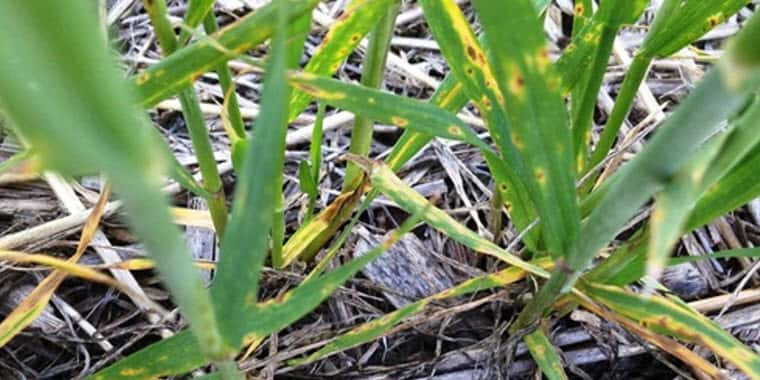by Emmanuel Byamukama, Assistant Professor & SDSU Extension Plant Pathologist
SDSU Plant Science Department

Figure 1. Heavy tillering and dead foliage may encourage early disease development. Picture taken April 12, 2016, Hand County.
The 2016 winter wheat growing season started with good crop establishment last fall. The heavy foliage produced last fall may have provided good inoculum build-up for spring infections to take place (Figure 1). Additionally, the mild winter may have led to the survival of several pathogens that would normally be killed. These conditions are contributing to an earlier than usual disease onset in winter wheat.
Stripe Rust
The first disease to watch for this season is stripe rust (Puccinia striiformis f. sp. trictici). Normally, stripe rust develops after jointing or later growth stages from spores that are blown from southern states. This year stripe rust was observed on initial leaves in winter wheat. Locally developing stripe rust inoculum and inoculum that may come from southern states may increase the risk for stripe rust this year. This rust develops under cool (<70° F) and wet weather conditions.
Tan Spot
Another disease that develops early in the season is Tan spot (Pyrenophora tritici-repentis). The tan spot pathogen survives on wheat residue and has a wide temperature range during which infection can take place. Symptoms include dark tan spots surrounded by a yellow halo on the lower leaves (Figure 2). Tan spot can be found in almost every wheat field but severity is usually high in no-till wheat following wheat.

Figure 2. Tan spot symptoms on leaves. Notice the dark center and a yellow halo around the lesion and also the heavy wheat residue.
Powdery Mildew
Powdery mildew was found in several winter wheat fields scouted last week (Figure 3). The powdery mildew pathogen (Blumeria graminis f. sp. tritici ) survives on wheat residue and infection is encouraged by wet and cool temperatures (60 – 72° F). Dense stands or heavy tillering also encourage infection. Moisture trapped in the lower canopy provides the perfect microclimate for powdery mildew development. Early infection of wheat by powdery mildew may lead to reduced tillering, and infected young tillers may fail to produce heads.
Figure 3. A wheat leaf showing powdery mildew developing. Cottony mycelium indicate a maturing lesion. Yellow spots on the leaves indicate young powdery mildew developing.
Fungicide Application Considerations
Flag leaf emergence is the recommended wheat growth stage for applying fungicides. Protection of the flag leaf and the leaf below flag leaf provides the best yield response. However, with early stripe rust developing now in winter wheat, an early fungicide application may be warranted. The decision to apply a fungicide should be based on the level of disease developing, the resistance rating of the cultivar planted, weather conditions in the forecast (drier conditions will limit disease progress), and grain prices. For fungicides that are effective against stripe rust and other fungal leaf spot diseases, see the fungicide efficacy table produced by the North-Central Wheat Pathology Working Group. Consult the 2016 Wheat Pest Management Guide for information on products labeled for use in South Dakota.
Source: iGrow, SDSU Extension



